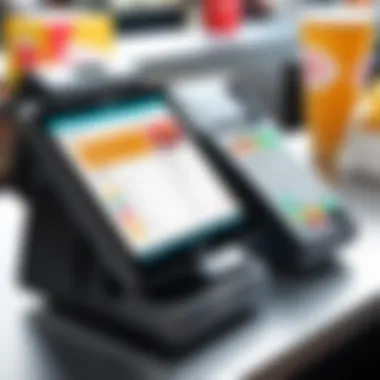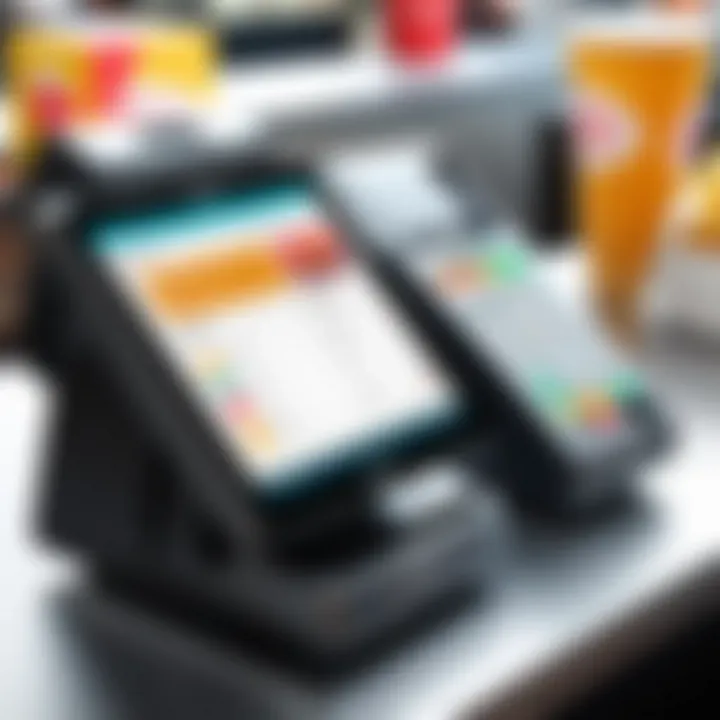Optimizing Fast Food Operations with POS Systems


Intro
The fast food industry is marked by a rapidly changing landscape, which requires robust management solutions to maintain productivity and customer satisfaction. The implementation of a Point of Sale (POS) system has become central to achieving this balance. It allows restaurants to streamline operations, manage transactions, and enhance customer experience. This article seeks to delve into the complexities of POS systems specifically designed for fast food establishments, thereby equipping business owners and IT professionals with the information needed to make informed decisions.
Software Overview
Brief Description of Software
A POS system encompasses hardware and software components working together to facilitate sales transactions. In fast food environments, the software aspect must cater to high-velocity service demand while ensuring accuracy and efficiency. Often, these systems are cloud-based, allowing for real-time data access and management. This capability is particularly beneficial for franchise operations, where maintaining consistency across locations is vital.
Key Features and Functionalities
Fast food POS systems come with functionalities tailored to their specific needs:
- Order Management: Streamlines order entry and processing. Allows for modifications with minimal disruption.
- Payment Processing: Supports multiple payment methods, including digital wallets and contactless payments, which are increasingly preferred by consumers.
- Inventory Tracking: Monitors stock levels and generates alerts when inventory is low. This minimizes waste and ensures timely reordering.
- Customer Relationship Management (CRM): Helps in managing customer data for improved service and personalized marketing strategies.
- Reporting and Analytics: Generates sales reports, aiding in business decisions and operational optimization.
"The right POS system can turn data into actionable insights, helping fast food restaurants improve performance and enhance customer satisfaction."
Detailed Comparison
Comparison with Competitors
When selecting a POS system, it is essential to assess how it stacks up against competitors. Systems such as Square, Toast, and Lightspeed offer distinctive advantages. For instance, Square is known for its user-friendly interface and flexible pricing structure, making it ideal for smaller establishments. In contrast, Toast offers advanced restaurant management features that are suited for larger chains, providing more comprehensive analytics tools.
Pricing Structure
Pricing for fast food POS systems varies widely, depending on features, scale, and service agreements. Most commonly, providers charge a monthly subscription fee that can range from $50 to $300, depending on the features selected. Additionally, transaction fees may apply, generally around 2.6% + $0.10 per transaction. Some systems require upfront hardware investments, while others may bundle hardware into their monthly subscriptions.
Choosing the right pricing structure involves careful consideration of both initial and ongoing costs, as well as the long-term financial implications for the restaurant.
By exploring these facets of POS systems, restaurant operators can make tactical decisions to enhance efficiency and elevate customer experience.
Intro to POS Systems
In the contemporary landscape of fast food restaurants, efficiency and customer satisfaction are paramount. The Point of Sale (POS) system serves as the central hub where sales transactions occur, making it a critical component for any food service operation. Understanding POS systems is essential for business leaders, IT professionals, and entrepreneurs alike. They streamline processes, automate tasks, and ultimately enhance profitability.
Definition and Purpose
A Point of Sale system refers to the hardware and software aimed at managing sales transactions. But its function extends beyond simply ringing up sales. POS systems integrate multiple operational aspects, such as inventory management and customer data analysis. Their purpose is to facilitate smooth transactions, reduce human error, and deliver insights into business performance.
It is also vital to consider how a POS system can help in financial reporting. These systems compile sales data and generate reports, enabling managers to track performance and make informed decisions.
The Evolution of POS Technology
POS technology has undergone a significant transformation since its inception. The early systems were mechanical, requiring manual entries and paper logs. However, with advances in technology, the shift to digital solutions started in the late 20th century. Today’s POS systems use cloud-based technology, allowing for real-time data access from multiple devices. This evolution has fundamentally changed how fast food restaurants operate.
Now, businesses can employ mobile applications linked to their POS system to enhance customer engagement and convenience. Furthermore, the integration of artificial intelligence and machine learning is beginning to influence POS capabilities, enabling predictive analytics that refine inventory control.
The growth in technology continues to shape the capabilities of POS systems. As user experience remains a key focus, the evolution of POS solutions seems poised to contribute even more substantially to operational success in fast food settings.
Significance of POS Systems in Fast Food Restaurants
Point of Sale systems have transformed the fast food industry over recent years. As restaurants face increasing pressure to optimize every aspect of their operations, the benefits offered by POS systems have become essential. These systems not only streamline processes but also provide invaluable insights that drive successful decision-making. It is crucial for business owners and managers to understand the significance of these systems as they directly relate to operational efficiency and customer satisfaction, two major drivers of success in this fast-paced environment.
Enhancing Operational Efficiency
The efficiency of operations in fast food restaurants can significantly improve through the implementation of an advanced POS system. These systems automate various tasks that were once manual, thus reducing errors and saving time. Order entry is one of the primary functions improved by POS systems. With a user-friendly interface, staff can swiftly take orders, which minimizes wait times and enhances service speed.
In addition, inventory tracking is streamlined. Modern POS systems can monitor stock levels in real-time, adjusting orders to suppliers automatically when thresholds are reached. This ensures that popular items are never out of stock, preventing lost sales and customer dissatisfaction.
"Efficiency is key in fast food; every second counts, and a good POS system can save those seconds."
Moreover, reporting features enable managers to analyze daily or weekly sales data, helping them identify trends and make informed decisions about staffing or menu adjustments. This leads to better management of resources and improved employee productivity. By integrating POS with other systems, such as employee scheduling and accounting, the overall operational workflow becomes significantly enhanced, allowing managers to focus on strategic growth instead of day-to-day minutiae.


Improving Customer Experience
Customer experience is paramount in fast food. A superior POS system contributes greatly to this aspect. Through faster order processing, customers enjoy reduced wait times, which is often a critical factor in their dining experience. An intuitive interface also allows for easier modifications and customization of orders, which caters to a wide range of customer preferences.
Additionally, POS systems often come with loyalty programs integrated. These programs reward frequent customers and encourage repeat business. Using data collected through the system, restaurants can personalize promotions based on individual customer buying behavior. This level of personalization builds a connection with customers and often leads to higher customer retention rates.
Training staff on a more streamlined POS system can also enhance service quality. When staff are comfortable and skilled in using the system, they can provide faster and more accurate service. This not only leads to customer satisfaction but also positively affects employee morale.
Core Features of Fast Food POS Systems
When it comes to enhancing operational efficiency in fast food restaurants, the core features of Point of Sale (POS) systems play an integral role. These features help streamline processes from the moment a customer places an order to when they receive their meal. A well-structured POS system will address the unique demands of the fast-paced fast food environment. Let's examine the essential components and their impact.
Order Management
Effective order management is crucial for fast food establishments. A robust POS system allows workers to take orders quickly and accurately. This minimizes errors that can lead to customer dissatisfaction. The system is designed to show menu items clearly and track orders in real-time. Consequently, employees can manage multiple customer requests effectively, avoiding delays during peak hours. Additionally, advanced functionalities like modifications and special requests help fulfill customer needs, enhancing their overall experience.
Payment Processing
Payment processing is a pivotal feature in POS systems. Fast food restaurants require quick and secure transaction methods to ensure customer satisfaction. Modern POS solutions support various payment types, such as credit/debit cards, mobile wallets, and gift cards. This flexibility caters to customer preferences while ensuring that funds are processed securely. Fast checkout speeds are necessary in the fast food industry, helping maintain a steady flow of customers. A swift payment processing system reduces wait times, keeping customers happy.
Inventory Management
Inventory management is often overlooked but is vital for efficient operations. A good POS system provides real-time tracking of stock levels, alerting management when supplies run low. This prevents situations where popular items are out of stock. It also helps identify trends in sales patterns, allowing restaurants to adjust their stock accordingly. Accurate inventory data can lead to cost savings. Understanding what items are sold most can aid in better purchasing decisions, ensuring freshness and availability.
Customer Relationship Management
Customer relationship management (CRM) is an often underutilized feature in fast food POS systems. This component allows restaurants to collect data about customer preferences and behaviors. With this information, establishments can tailor their marketing efforts and promotions effectively. For instance, by tracking repeat orders, a restaurant can offer personalized deals to attract loyal customers. Understanding customer patterns improves service and enhances customer satisfaction, which is crucial for retention in a highly competitive market.
Reporting and Analytics
In a competitive landscape, fast food restaurants benefit greatly from insights driven by reporting and analytics. A comprehensive POS system offers powerful reporting tools that can analyze sales trends, employee performance, and inventory levels. Decision-makers can review daily, weekly, or monthly reports to identify areas of success and those needing improvement. This data-driven approach facilitates informed decisions, allowing restaurants to adapt strategies and maximize profitability. Furthermore, the ability to forecast demand helps in efficient resource planning, leading to smoother operations and enhanced customer experiences.
"The effectiveness of any fast food restaurant depends significantly on how well the core features of its POS system are implemented and utilized."
In summary, the core features of fast food POS systems play a crucial role in ensuring successful operations. Mastery in order management, payment processing, inventory management, CRM, and reporting builds a more efficient environment that meets customer needs and attracts repeat business.
Types of POS Systems for Fast Food Restaurants
Point of Sale systems are essential to the operations of fast food restaurants. Choosing the right type of POS system can greatly affect how efficiently the restaurant runs. Different systems offer unique advantages that can cater to various business needs. Consequently, understanding the types of POS systems is crucial for making informed decisions.
Cloud-Based POS Solutions
Cloud-based POS solutions are increasingly popular among fast food restaurants. These systems operate over the internet, which means data can be accessed from anywhere. Restaurants benefit from real-time data analysis, allowing for quick adjustments in inventory or pricing.
With cloud-based systems, there is often reduced upfront investment compared to traditional systems. Monthly subscription fees can be more manageable than a significant initial purchase. Moreover, updates and maintenance are usually handled by the provider. This reduces the burden on the restaurant’s IT resources. Security is also generally robust, as leading providers have advanced measures in place to protect sensitive data.
On-Premise POS Systems
On-premise POS systems are the traditional choice. These are installed directly on restaurant hardware and operate independently of the internet. For businesses in areas with weak connectivity, an on-premise solution ensures consistent performance. It can be more suitable for fast food locations that require a greater level of control over their data.
However, while on-premise systems can be robust, they often require larger initial investment. Maintenance and upgrades must be managed in-house, increasing long-term operational involvement. Thus, they may not be as scalable as cloud systems. Yet, for some fast food establishments, the control and reliability of an on-premise system justify these downsides.
Mobile POS Solutions
Mobile POS solutions represent a modern trend. They allow staff to take orders and process payments on handheld devices. This flexibility enhances customer interaction and speeds up service times. For fast food joints, where efficiency is key, being able to serve customers at their tables or in line can reduce wait times.
These systems also offer the advantage of mobility. Staff can carry devices in the restaurant, which enables a more personalized service. They can access inventory and customer information instantly. Additionally, mobile solutions can integrate with other POS systems, creating a seamless operational flow.
While mobile systems may require compatible hardware and training, their benefits can outweigh initial hurdles. Businesses that prioritize customer experience find these systems increasingly valuable.
The right type of POS system enhances operational efficiency and customer satisfaction across fast food restaurants.
Understanding these types of POS systems allows fast food restaurant owners to make better choices. Whether considering cloud-based, on-premise, or mobile systems, each option offers critical advantages tailored to specific operational requirements.
Benefits of Implementing a POS System


Implementing a Point of Sale (POS) system in fast food restaurants offers numerous advantages that significantly enhance operational efficiency and improve overall customer service. These benefits can be categorized into specific areas that impact the restaurant's bottom line. Understanding these advantages helps restaurant owners make informed decisions about technology adoption.
Cost Reduction
One of the most compelling reasons to implement a POS system is cost reduction. This technology streamlines various processes, which leads to lower operational costs. For instance, a POS system automates tasks that would normally require extensive human labor, such as order entry and inventory management. By minimizing labor costs, fast food restaurants can reallocate resources to other areas, like marketing or improving the menu.
Moreover, a well-implemented POS system can reduce the occurrence of human error in order processing, leading to improved accuracy in order fulfillment. Errors in orders can be costly due to food wastage and customer dissatisfaction. With a POS system, these issues are minimized, allowing for a more profitable operation.
Another aspect is the reduction of inventory losses by tracking stock levels more accurately. Fast food chains can avoid over-ordering or running out of essential ingredients, thereby optimizing costs related to inventory management.
Speed of Service
In the fast-paced environment of a fast food restaurant, speed is crucial. A POS system significantly enhances the speed at which orders are taken, processed, and delivered. Staff can enter orders quickly into the system, and the automated process sends these orders directly to the kitchen. This efficiency reduces wait times for customers, which is a critical factor in the fast food industry.
Additionally, features like menu customization and quick payment processing allow for seamless transactions. Customers appreciate a quick dining experience, which helps build loyalty and encourages repeat visits. The speed of service also means that more customers can be served during peak hours, increasing sales potential.
Data-Driven Decision Making
Data analysis is essential in today’s competitive food industry. A POS system provides valuable insights into sales trends, customer preferences, and inventory levels. The reporting capabilities available allow restaurant owners to analyze this data effectively, leading to informed decision making.
For example, by examining sales data, managers can identify which menu items are most popular and which ones are not performing as expected. This insight enables them to make strategic decisions, such as adjusting menu offerings or timing promotions for maximum impact.
Moreover, understanding customer preferences can assist in personalized marketing efforts, targeting specific demographics with promotions tailored to their tastes. Data-driven decision-making ultimately supports the long-term growth and sustainability of fast food restaurants.
"Incorporating a POS system is not just a technological upgrade; it is a strategic move that builds a foundation for future growth."
By knowing the benefits of implementing a POS system, fast food restaurant owners can align their technology choices with their business goals. The resulting improvements in cost control, service speed, and data analysis are critical elements in thriving within the fast food industry.
Challenges in Adopting POS Systems
Adopting a robust Point of Sale (POS) system in fast food restaurants can be transformative, yet it also presents several challenges. Understanding these challenges is crucial for decision-makers and IT professionals, as they directly impact the effectiveness of the implementation. Addressing these challenges carefully ensures the smooth operation of fast food restaurants, which often deal with high volume and the necessity for speed.
Integration with Existing Systems
Integrating a new POS system with existing operational software is often one of the most daunting tasks. Fast food restaurants typically rely on various systems to manage order processing, inventory, and customer relationships. For instance, if a business uses a separate inventory management system like Square or Toast, syncing data with the new POS solution becomes essential yet complicated.
Common issues may include data inconsistency and system compatibility. It is crucial to conduct a thorough analysis of current systems to determine the level of integration needed. Additionally, choose a POS system that offers robust APIs to facilitate links with existing solutions. This approach minimizes disruptions during the transition and maximizes the benefits of modern technology.
Training Staff
Another critical challenge is the training of staff on the new POS system. Fast food environments are often fast-paced, and staff members need to learn the system without affecting service quality. Providing adequate training can be resource-intensive, but it is necessary for successful adoption.
Training should include not just the operational aspects of the POS but also handling customer queries effectively within the system. Different approaches can be employed:
- On-site training sessions: Engage employees directly in a controlled setting.
- Online tutorials: Offer flexibility for team members to learn at their own pace.
- Shadowing experienced users: Allow less experienced staff to learn from seasoned employees.
This comprehensive training leads to improved service levels and minimizes errors during busy periods.
Cost of Implementation
Finally, the cost of implementing a new POS system can be a considerable hurdle. Beyond the initial purchase price, additional costs include hardware purchases, software licenses, integration services, and ongoing maintenance fees.
Estimating total costs accurately requires careful consideration of these elements. Speedy implementation and ongoing support can often lead to lower long-term costs through increased efficiency.
- Considerations for budgeting include:
- Initial system cost and deployment expenses.
- Hardware costs for terminals and peripherals.
- Subscription fees for cloud-based systems.
- Training expenses for staff.
Investing wisely requires decision-makers to perform a thorough cost-benefit analysis that weighs potential returns against expenses incurred.
The successful adoption of a POS system requires navigating integration, training, and cost challenges effectively.
Choosing the Right POS System


Choosing the right Point of Sale (POS) system is critical for fast food restaurants. The implications of this decision extend beyond mere transactions and affect customer experience, operational efficiency, and overall profitability. A well-suited POS system can streamline processes, reduce errors, and enhance service speed. Therefore, the selection process merits close attention and thorough evaluation.
Assessing Business Needs
Understanding the unique needs of your business is the first step in selecting a POS system. Each fast food outlet has its specific requirements based on size, menu complexity, and customer flow. Factors to consider include:
- Volume of Sales: High-volume restaurants might require a more robust system with features like multiple terminal support.
- Menu Complexity: A complex menu with numerous items may need advanced order management capabilities.
- Customer Interaction: If your restaurant uses loyalty programs, features that support these programs are essential.
- Integration Needs: Existing systems, like payroll or inventory, should work seamlessly with your new POS.
Taking these elements into account helps narrow down options and focus on systems that can adapt to your operational structure and scale as needed.
Evaluating Vendor Options
Once business needs are assessed, it becomes important to evaluate potential vendors thoroughly. The market offers a variety of POS providers, each presenting unique features and benefits. Here are key aspects to consider:
- Reputation and Experience: Research vendors’ histories, customer reviews, and case studies to gauge their reliability.
- Technical Support: Ensure vendors offer comprehensive support, including installation, training, and troubleshooting.
- Customization: Evaluate how easily the system can be tailored to your specific operations. Customization is particularly important for unique menu offerings and service models.
- Pricing Structure: Analyze costs not only in terms of initial investment but also ongoing fees for maintenance, updates, and additional features.
A systematic approach to vendor evaluation can ensure the selected POS system aligns with your business strategy and operational goals.
Cost-Benefit Analysis
A thorough cost-benefit analysis is essential to making an informed decision when selecting a POS system. It helps in understanding whether the system costs justify the potential gains. Assessing costs involves:
- Initial Setup and Implementation Costs: Include hardware, software, and installation expenses.
- Training Costs: Account for any costs related to training staff on the new system.
- Ongoing Support and Maintenance Fees: Consider any recurring fees that may apply.
On the benefit side, potential gains might include:
- Increased Efficiency: A streamlined process can lead to faster service and potentially higher customer turnover.
- Error Reduction: Accurate order processing decreases mistakes, resulting in higher customer satisfaction.
- Enhanced Data Insights: The system may provide valuable analytics that inform business decisions and promote growth.
In conducting this analysis, consider both qualitative and quantitative factors, as the right POS system should ultimately contribute to improving the bottom line and customer experience.
"Choosing the right POS system is not just a purchase; it's a strategic decision that affects all facets of a fast food restaurant's operations."
By focusing on these aspects, fast food operators can make an informed decision that aligns with their specific operational needs and long-term goals.
Future Trends in POS Systems for Fast Food
Understanding the future trends in POS systems is vital for fast food restaurants looking to stay competitive. As technology evolves, so do the demands of consumers and the operational needs of the business. Among the prominent trends, we see advancements in artificial intelligence, mobile payment solutions, and personalized customer experiences. Each of these trends offers specific benefits and considerations that can significantly impact how fast food establishments operate.
Artificial Intelligence Integration
Artificial intelligence is reshaping the landscape of POS systems in fast food services. AI can analyze customer data to predict ordering patterns, which allows restaurants to optimize their menu and inventory. Moreover, integrating AI-enabled chatbots can enhance customer service by providing immediate responses to common inquiries. These technologies not only increase efficiency but also reduce human error, ensuring a smoother transaction process.
Notably, AI can also assist in employee training by offering real-time support during peak hours. For instance, it can provide suggestions to staff on upselling items based on customer behavior and past purchases. This level of customization helps in increasing sales while simultaneously improving customer satisfaction.
Mobile Payment Solutions
In recent years, mobile payment solutions have gained significant traction among consumers. Fast food restaurants that embrace these solutions can streamline the payment process. Options like Apple Pay, Google Pay and other mobile wallets allow customers to complete transactions in a hassle-free manner. The ease of payments via smartphones enhances customer experience, as it reduces waiting time at the counter.
Furthermore, mobile payment systems often integrate with loyalty programs. Customers can earn rewards more effortlessly, which promotes returning business. For restaurant operators, these systems can provide valuable insights through transaction data, aiding in financial tracking and decision-making.
Personalized Customer Experiences
Personalization has become a cornerstone of consumer expectations across all sectors, including fast food. Advanced POS systems allow restaurants to create personalized experiences based on past customer interactions. By accessing loyalty program data, restaurants can tailor offers and promotions, especially on birthdays or anniversaries.
Also, collecting feedback through POS systems enables restaurants to adapt their offerings. Analyzing customer preferences can inform menu design and promotional strategies. This targeted approach encourages customer loyalty, as individuals feel valued and understood.
End
The significance of Point of Sale (POS) systems in fast food operations cannot be overstated. They serve as the backbone of daily transactions, enabling quick service and effective management. As the fast food industry evolves, these systems adapt, integrating new technologies that enhance efficiency and provide better customer experiences. Understanding the critical role of POS systems is essential for decision-makers and entrepreneurs looking to optimize their business operations.
Summarizing the Importance of POS Systems
POS systems bring several advantages to fast food restaurants. First, they streamline various processes, from order taking to payment processing. This leads to increased operational efficiency. Moreover, the data collected via POS systems allows restaurants to make informed decisions. For instance, sales reports can highlight peak hours, informing staffing and inventory decisions.
The importance of these systems also lies in enhancing the customer experience. Speed and accuracy in service are crucial in a fast-paced environment. With a reliable POS system, orders can be taken and processed quickly, reducing wait times. Furthermore, features such as loyalty programs can help build long-term customer loyalty, significantly impacting restaurant revenue.
Final Thoughts on Future Developments
Looking ahead, the evolution of POS technology remains promising. Trends such as artificial intelligence integration and mobile payment solutions are likely to reshape the way fast food restaurants operate. AI can analyze customer preferences, enabling restaurants to tailor their offerings more effectively.
Additionally, as mobile payment solutions increase in popularity, facilitating transactions becomes simpler and faster. Restaurants adopting these innovations can expect not only to enhance customer satisfaction but also increase their competitive edge.







